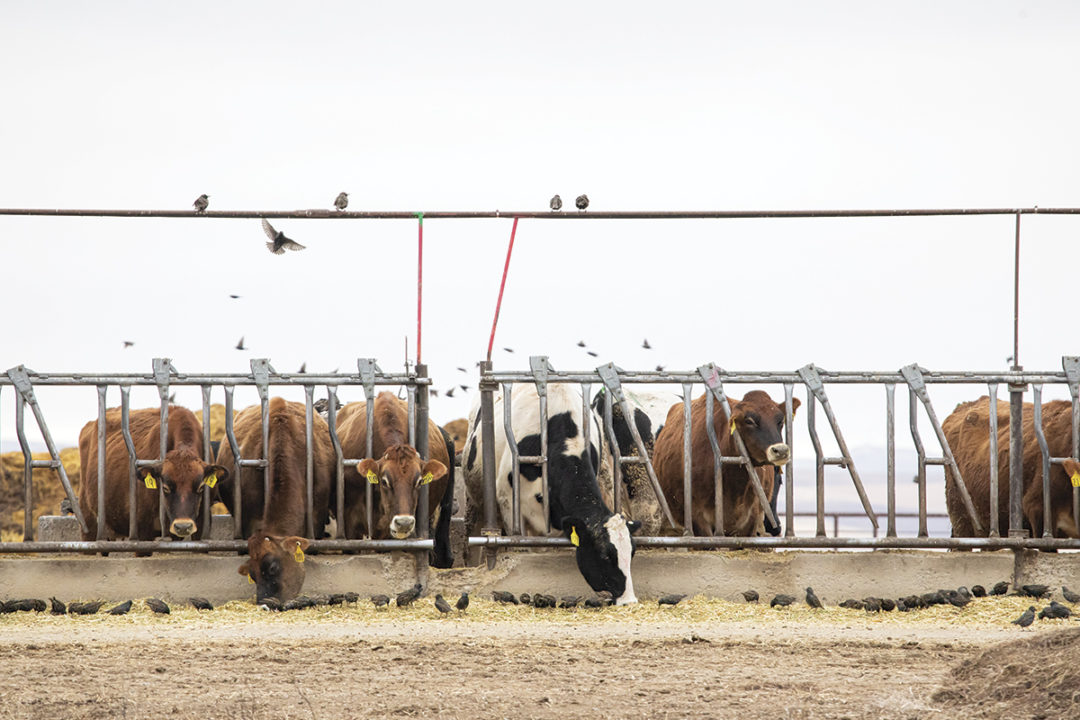Birds are pests on farms and ranches, consuming and contaminating feed intended for cattle and fruit. The problem has been compounded with growing herd size, leading to increased use of open commodity sheds for easy access by both loaders and foraging birds.
“European starlings [an invasive species] cause a tremendous amount of damage to livestock feed,” says Jared Hedelius, Idaho state director for USDA Wildlife Services. “Canada and snow geese are also a growing concern for many farms. They do eat a lot of ag crops as they grow, which can produce less yield – and, if severe enough, can kill the crop. Snow geese can even be more detrimental to ag crops because they congregate in such high numbers. Seagulls are also a concern with livestock feed or grains in some situations.”
According to the USDA Wildlife Damage Management Technical Series, European Starlings, “Starlings damage apples, blueberries, cherries, figs, grapes, peaches and strawberries. Besides causing direct losses from eating fruits, starlings peck and slash at fruits, reducing product quality and increasing the fruits’ susceptibility to diseases and crop pests.”It continues, “Starlings prefer facilities with open feeder systems which provide easy access to livestock rations.”
“Bird control can be very expensive; bird damage can be even more expensive. The USDA Wildlife Service assists numerous farmers and livestock producers throughout Idaho with different birds causing damage to different property,” says Hedelius.
“With the example given regarding European starlings, these birds congregate during the winter months around confined livestock operations to feed in silage pits; commodity areas where corn, grain, etc., are stored; and feed within the feedbunks,” Hedelius says. “Addressing these large numbers of birds around livestock and livestock feed can be difficult. It seems like European starlings come into these areas by the thousands throughout the whole winter.”
According to the Animal and Plant Health Inspection Service’s (APHIS) website, typical methods for controlling starling damage include a combination of harassment, exclusion, pyrotechnics, shooting and trapping. Non-lethal methods, such as exclusion, have proven effective at reducing starling damage to fruit crops. Nightly harassment at roost sites utilizing lasers, or in some cases habitat modification to remove roost trees and structures, may be needed to deter starlings from using an area. Limiting the availability of food and water is another major key to controlling starling damage, especially on dairy farms. This may include changing livestock feeding schedules and reducing pooled water levels in watering tanks.
Certified staff may use pesticides such as DRC-1339 concentrate or sodium lauryl sulfate.
The website further states that delaying planting or providing alternate feeding sites, as well as timely crop harvest, can reduce damage to agricultural areas. Harassment using propane exploders and pyrotechnics, visual bird frightening devices such as Mylar tape and animated scarecrows, frightening with pesticide agents such as Avitrol, and repellents have proven successful at reducing damage. Lethal shooting can be used to reinforce harassment efforts.
APHIS has a program for depredation by waterfowl from feedlots to airports. Hedelius says, “It is a little more complicated than one might think. In order to deal with waterfowl, you have to have a migratory bird depredation permit. This permit is issued by the U.S. Fish and Wildlife Service. I have my own permit and can assist at feedlots and airports, but my staff is limited so I encourage landowners and airports to apply for their own permits. I can help them apply, but I do not issue the permits.”
“European starlings pick out the grain, corn and other high-protein products within the feed rations,” Hedelius says. “Their feces cover the livestock feed, which is ingested by the cattle and can be a huge disease concern. Their feces also cover the feedbunks, fences, buildings, etc.” Diseases range from salmonella to gastrointestinal diseases in livestock.
According to APHIS’s website: Starlings and other birds also congregate at cattle feedlots and dairies, where they consume high-protein supplements in livestock feed, leading to contamination and possible disease transmission within and between livestock facilities. A 2009 survey of Pennsylvania dairy producers suggests that veterinary costs at dairies with starling flocks numbering between 1,000 and 10,000 birds were 38% higher ($91 per cow per year) than at dairies without starlings ($66).
According to the USDA Wildlife Damage Management Technical Series, European Starlings, “A flock of 1,000 starlings using a CAFO for 60 days during winter will eat about 1.5 tons of cattle feed, representing a loss of $200 to $400 per 1,000 starlings. About 250,000 starlings that were using a Midwestern feedlot increased the cost of feeding a ration of steam-flaked corn by $43 per heifer over a 47-day period between mid-January and March. Costs in lost production [i.e., livestock weight gained per unit feed consumed] over this period was $1 per animal.
“European starlings, geese and gulls eat the feed. They do not store [cache] the feed,” says Hedelius. “Depending on how aggressive the farmer or livestock producer wants to be, there can be hundreds to tens of thousands of dollars spent on bird control at a single property per year.”
One of APHIS’s programs addresses wildlife damage management. “We partner with APHIS for control,” says Darcy Helmick, a Simplot land manager in Grand View. “It is critically important that APHIS continues to receive funding and political support to continue these efforts.”
“Grains and other commodities should be stored under secure tarps or within sheds or buildings. This can be an expensive investment upfront, but it will pay for itself over time with a reduction of commodities consumed by birds or destroyed by bird feces. Seagulls and ravens can be aggressive enough to destroy tarps to get to the feed,” says Hedelius.








